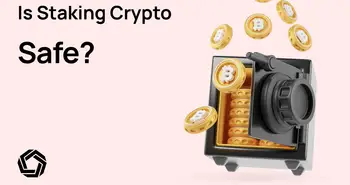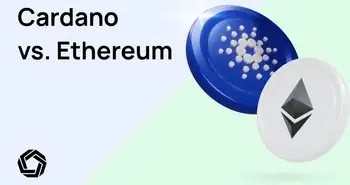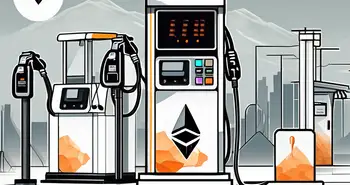Stake Your ETH: The Ultimate Guide to Ethereum 2.0 and Passive Earnings

Ethereum 2.0 is the next major upgrade for the Ethereum blockchain, and one of its most highly anticipated features is staking. In this ultimate guide, I will walk you through everything you need to know about Ethereum 2.0 staking, from understanding the basics to getting started and managing potential risks.
What is Ethereum 2.0?
Ethereum 2.0, also known as Eth2 or Serenity, aims to overcome some of the limitations of the current Ethereum network, such as scalability and energy efficiency. It introduces a new consensus algorithm called Proof of Stake (PoS) to replace the existing Proof of Work (PoW) algorithm.
Unlike PoW, where miners solve complex mathematical problems to validate transactions and create new blocks, PoS relies on validators who lock up a certain amount of Ether (ETH) as a stake to participate in block validation. Validators are randomly selected to propose and attest new blocks based on the amount of ETH they hold as a stake.
Key Features of Ethereum 2.0
Ethereum 2.0 brings several key features that make it an exciting upgrade:
Scalability: Ethereum 2.0 introduces shard chains, which will allow the network to process multiple transactions in parallel, greatly increasing its capacity. Currently, the Ethereum network faces congestion issues during times of high demand, leading to slower transaction times and higher fees. With shard chains, the network will be able to handle a larger volume of transactions, ensuring smoother and faster operations for users.
Energy Efficiency: Unlike PoW, where miners consume significant amounts of electricity, PoS is more energy-efficient because it doesn't require miners to solve complex mathematical problems. This change not only reduces the carbon footprint of the Ethereum network but also makes it more sustainable in the long run.
Security: PoS brings a higher level of security by making it economically costly for validators to attempt any malicious behavior. Validators who act dishonestly can lose their staked ETH. With PoS, validators have a financial stake in the network. This means that if they act dishonestly or attempt any malicious behavior, they stand to lose their staked ETH. This economic incentive acts as a powerful deterrent against fraudulent activities, ensuring a higher level of security for the Ethereum network.
The Basics of Staking
What is Staking?
Staking is the process of locking up a certain amount of cryptocurrency to support the operations of a blockchain network. By doing so, stakers contribute to the network's security and consensus mechanism. In return for their contribution, stakers are rewarded with additional cryptocurrency. Staking offers a way to earn passive income while actively participating in maintaining the network's integrity.
Benefits of Staking
Staking offers several benefits for cryptocurrency holders:
- Earn Passive Income: By staking your cryptocurrency, you have the opportunity to earn additional tokens as rewards for supporting the network.
- Support Network Security: Staking contributes to the security of the network by encouraging participants to act honestly and verify transactions.
- Participate in Governance: Some blockchain networks allow stakers to participate in the decision-making process by voting on protocol upgrades or changes.
Ethereum 2.0 Staking Explained
How Does Ethereum 2.0 Staking Work?
In Ethereum 2.0, anyone with a minimum of 32 ETH can become a validator and participate in the staking process. Validators lock up their 32 ETH as a stake and run a software client to validate and propose blocks. Validators are chosen to propose blocks randomly and are assigned shards to attest to the validity of transactions within those shards. The more ETH a validator holds, the higher their chances of being selected to propose blocks and earn rewards.
The Role of Validators in Staking
Validators play a crucial role in the Ethereum 2.0 staking ecosystem. Their responsibilities include:
- Block Proposal: Validators are responsible for proposing new blocks and adding them to the blockchain.
- Attestation: Validators verify and attest to the validity of transactions within their assigned shard chains.
- Finalization: Validators participate in the finalization process, where blocks are confirmed and become irreversible.
Getting Started with Ethereum 2.0 Staking
Requirements for Staking on Ethereum 2.0
To become an Ethereum 2.0 validator, you need to meet the following requirements:
Minimum 32 ETH: You need a minimum of 32 ETH to become a validator.
Technical Setup: You'll need a computer or server with sufficient hardware and a reliable internet connection to run a validator client.
Ethereum 2.0 Client: Choose a compatible Ethereum 2.0 client software, such as Prysm, Lighthouse, or Teku, and set it up on your machine.
Step-by-Step Guide to Staking
Here's a step-by-step guide to help you start staking on Ethereum 2.0:
- Acquire the minimum required 32 ETH.
- Set up a secure and reliable Ethereum 2.0 client on your machine, such as Prysm, Lighthouse, or Teku.
- Generate or import your Ethereum 2.0 deposit keys. These keys will be used to secure and access your staked ETH.
- Go through the deposit process to send your ETH to the Ethereum 2.0 deposit contract. This contract will hold your staked ETH.
- Set up and run your validator client, linking it with your deposit keys.
- Monitor your validator's performance and take required actions to maintain optimal uptime.
Risks and Challenges of Ethereum 2.0 Staking
Understanding the Risks
Here are some risks associated with Ethereum 2.0 staking:
Slashing: Validators may be penalized or have their stake partially slashed for malicious or negligent behavior, such as going offline or validating invalid blocks.
Volatility: The price of ETH can be volatile, which means the value of your staked assets may fluctuate.
Technical Issues: Running a validator client requires technical expertise, and any issues with the client or infrastructure may lead to missed rewards or penalties.
Overcoming the Challenges
To mitigate the risks and challenges of Ethereum 2.0 staking, it's important to:
Stay Informed: Keep up to date with the latest developments and stay informed about any protocol changes or updates.
Secure Your Environment: Implement robust security measures to protect your validator keys and ensure the safety of your staked ETH.
Monitor Performance: Regularly monitor your validator's performance and take prompt action to address any potential downtime or issues. To keep up with the latest ETH market updates, check Morpher AI Ethereum market insights page!
Frequently Asked Questions (FAQ)
What is Ethereum 2.0?
Ethereum 2.0 is an upcoming major upgrade to the Ethereum blockchain, introducing new features like Proof of Stake (PoS) consensus, shard chains for scalability, and increased energy efficiency.
What is staking?
Staking refers to the act of locking up a certain amount of cryptocurrency to support the operations and security of a blockchain network. Stakers are rewarded with additional tokens for their contribution.
How does Ethereum 2.0 staking work?
In Ethereum 2.0, validators lock up a minimum of 32 ETH as a stake to participate in block validation and proposal. Validators are randomly selected and play a crucial role in verifying transactions and maintaining network security.
What are the requirements to stake Ethereum 2.0?
To stake Ethereum 2.0, you need a minimum of 32 ETH, a reliable internet connection, a compatible Ethereum 2.0 client software, and a secure technical setup.
What are the risks of Ethereum 2.0 staking?
Ethereum 2.0 staking carries risks such as slashing, volatility in cryptocurrency prices, and technical issues. Educating yourself, implementing security measures, and closely managing your staking setup can help mitigate these risks.
In conclusion, Ethereum 2.0 staking is an exciting opportunity for cryptocurrency holders to earn passive income while supporting the Ethereum network. By understanding how Ethereum 2.0 works, meeting the requirements, and actively managing the risks, you can participate in this groundbreaking technology and contribute to the growth of the blockchain ecosystem.
Ready to take your Ethereum 2.0 staking to the next level? Join Morpher, the revolutionary trading platform that's reshaping the investment landscape. With Morpher, you can trade Ethereum and a vast array of other assets with zero fees, infinite liquidity, and the safety of a non-custodial wallet. Whether you're looking to invest fractionally, short sell without interest fees, or leverage your trades up to 10x, Morpher offers a unique and flexible trading experience on the Ethereum Blockchain. Sign Up and Get Your Free Sign Up Bonus today to start trading like never before!

Disclaimer: All investments involve risk, and the past performance of a security, industry, sector, market, financial product, trading strategy, or individual’s trading does not guarantee future results or returns. Investors are fully responsible for any investment decisions they make. Such decisions should be based solely on an evaluation of their financial circumstances, investment objectives, risk tolerance, and liquidity needs. This post does not constitute investment advice.

Painless trading for everyone
Hundreds of markets all in one place - Apple, Bitcoin, Gold, Watches, NFTs, Sneakers and so much more.

Painless trading for everyone
Hundreds of markets all in one place - Apple, Bitcoin, Gold, Watches, NFTs, Sneakers and so much more.









